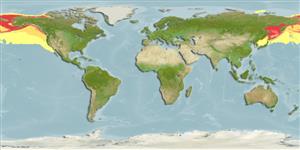Common names from other countries
Environment: milieu / climate zone / depth range / distribution range
Écologie
Bathydémersal. Subtropical; 90°N - 0°S, 126°E - 115°W
Distribution
Pays | Zones FAO | Écosystèmes | Occurrences | Introductions
Pacific Ocean and the Arctic: Eastern side of Ostrov Sakhalin to northern Hokkaido. Subtropical to polar.
Length at first maturity / Taille / Poids / Âge
Maturity: Lm ? range ? - ? cm Max length : 170 cm TL mâle / non sexé; (Ref. 1394); 160 cm TL (female); poids max. publié: 123.0 kg (Ref. 1394)
Inhabit the southern edges of the pack ice from winter to early summer and coastal areas including river mouths, in late summer and autumn. Diet composition varies with the age of the seal; Newly weaned pups feed on small crustaceans, advance to schooling fishes, larger crustaceans, and octopuses, and finally graduate to bottom dwelling fish and cephalopods (Ref. 1394).
Jefferson, T.A., S. Leatherwood and M.A. Webber. 1993. (Ref. 1394)
Statut dans la liste rouge de l'IUCN (Ref. 130435: Version 2024-1)
statut CITES (Ref. 108899)
Not Evaluated
Not Evaluated
Utilisations par l'homme
Pêcheries: commercial
FAO - pêcheries: landings, species profile | FishSource | Sea Around Us
Outils
Sources Internet
Estimates based on models
Preferred temperature
(Ref.
115969): -0.6 - 5.6, mean 2.2 (based on 1984 cells).
Résilience
Milieu, temps minimum de doublement de population : 1,4 à 4,4 années (K=0.16-0.44).
Vulnérabilité
High to very high vulnerability (72 of 100).
Catégorie de prix
Unknown.
